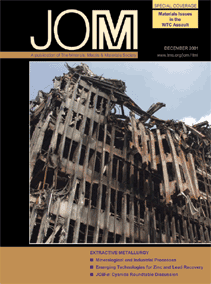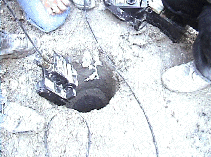 |
NEWS & UPDATE
|
|---|
 |
NEWS & UPDATE
|
|---|
|
|
|
|---|---|
 |
OTHER ARTICLES IN THE WTC
SERIES
Why Did the World Trade Center Collapse? Science, Engineering, and Speculation by Thomas Eagar and Christopher Musso Better Materials Can Reduce the Threat from Terrorism by Toni G. Maréchaux An Initial Microstructural Analysis of A36 Steel from WTC Building 7 by J.R. Barnett, R.R. Biederman, and R.D. Sisson, Jr. |
|
|
|
|
Figure 2. A robot
prepares to enter a pipe to provide a view under the rubble of collapsed
buildings.
|
 |
|
|
|
They may have looked like toys, but the remote-controlled vehicles that crawled
through the World Trade Center debris had a most serious mission: to find
victims.
One team of robots was the work of the Center for Robot-Assisted Search and
Rescue (CRASAR), out of the University of South Florida. As many as 17 CRASAR
robots were on hand hours after terrorists leveled the twin towers. Other
robots, supplied by the U.S. Navy and private companies, also searched the
wreckage.
The CRASAR robots ranged from the size of a shoebox to that of a large suitcase.
Most rolled on tank treads for better mobility on rugged terrain. Sensors
provided the robots with a variety of capabilities. Some could detect heat
through infrared cameras, others provided two-way audio communication through
the use of a headset and microphone, and still others could provide color
video.
Operators sent the robots, which were attached to a 30 meter tether, to explore
openings in the rubble, such as holes or exposed pipes, searching for signs
of life (Figure 2).
“This was the first known use of robots for urban search and rescue,”
said Robin Murphy, an associate professor of computer science and robot expert
with CRASAR. “These robots were going places you couldn’t put a
dog or a person in.” No living victims were found, but five bodies were
discovered and one set of remains.
Murphy’s research on rescue robots was originally funded by the National
Science Foundation (NSF). The robots, which ranged in cost from $10,000 to
$40,000, offered a significant improvement over fire department cameras used
to peer into tight spaces. Those cameras were attached to two meter wands,
according to the NSF.
Direct questions about this or any other JOM page to jom@tms.org.
| If you would like to comment on the December 2001 issue of JOM, simply complete the JOM on-line critique form | |||||
|---|---|---|---|---|---|
| Search | TMS Document Center | Subscriptions | Other Hypertext Articles | JOM | TMS OnLine |